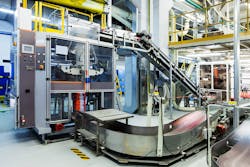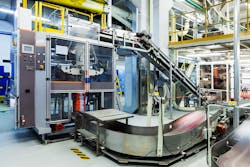Stepper Motors Step Up for Machine Automation (.PDF Download)
Engineers rely on motion-control devices to improve efficiencies and production rates on automated factory floors, or at least maintain them. One family of such devices, stepper motors, is widely used because of their simple implementation, attractive price/performance ratio, and high torque at low speeds. In the past, stepper motors couldn’t keep up with servo motors in demanding applications, but recent advances have greatly upgraded stepper-motor performance, expanding the areas in which they can make positive differences.
Stepper motors are often used in demanding applications, such as this packaging machine.
Here’s a look at those advances, and an overview of the other two leading motion-control devices for machine automation: servo motors and variable-frequency drives (VFDs).
The Top Three Motor/Drive Types
Engineers can choose from numerous varieties of motors, drives, and controllers to meet the demands of the application at hand, such as torque, speed, and size.
Stepper motors generally include a motor, drive, and controller. The motor, a brushless dc version, moves in equally sized fixed steps during rotation, and only rotates one step at time. Stepper motors have simple designs and controls, and don’t require tuning or adjustment. They provide excellent torque at speeds under 1,000 rpm and are one-half to one-third the cost of comparable servo systems. Their output torque decreases as their speed (rpm) increases, making them difficult to operate. Not only that, it’s tough to get useful work out of them at speeds above 1,000 rpm for dc-powered applications and above 1,500 rpm for ac-powered ones.
Servo motors consist of a motor, drive, controller, and a positional feedback device. They can deliver high torque at speeds above 2,000 rpm, and are preferred over stepper motors for variable load applications. They are also more complex to control than stepper motors and require tuning and adjustments. Position feedback, together with upfront plus maintenance costs, push their prices above those of stepper motors. At about $2,000 (USD) per axis, cost is considerably higher than stepper-motor systems.
VFDs include an ac motor and a drive and cost less than steppers or servo motors, but cannot provide positioning. They do, however, offer good speed control, even with variable loads. A VFD also saves energy in applications where the motor does not need to run continuously at full load. Furthermore, VFDs have built-in soft-start capabilities to limit inrush currents.

